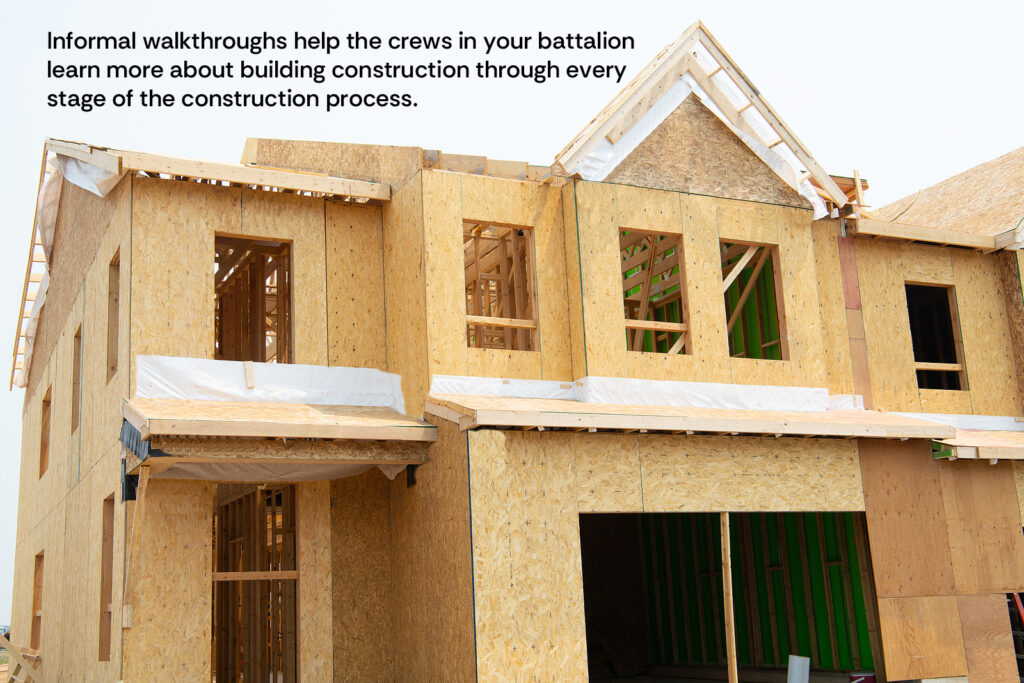Level up construction knowledge, build camaraderie & check out response areas with informal walkthroughs.
June 20, 2025Battalion-Level Leadership
Level up your battalion's construction knowledge, build camaraderie & check out response areas with informal walkthroughs.
By Adam Jackson
B Shifter Buckslip, June 24, 2025.

When I started my fire service journey, I worked for a three-station department with one training officer. We had limited formal training. (My definition of formal is training prepared and often presented by the training division.) Most of my training was passed down from the officers and senior firefighters. The “drills” I enjoyed the most were informal building walkthroughs.
Because I did not come from a construction background, I enjoyed learning about building construction from those had that experience. We focused our tours on old buildings (early 1900s) in the downtown core or new construction our fire prevention division would bring to our attention. We would assure the building and business owners that we were not doing an inspection and asked if we could conduct a walkthrough to be better prepared should anything happen to their building.
Capt. John Davis was a great resource; he shared his extensive knowledge of building types and characteristics, explaining king rows, corbels, tie rods and steel bar joists. He answered all my rookie questions, often showing me an example to help me understand the concepts. As we walked through narrow alleys, Capt. Davis showed me access doors for attics, second floors or mezzanines that would prove crucial if the building were to have a fire. We discussed apparatus placement for engines and ladders, incorporating overhead lines, collapse zones, narrow streets and other challenges. These early lessons stuck with me and made me a big proponent of walkthroughs.
As incident commanders, we often rely on the company officer’s knowledge, skills and abilities to set the scene for us. Walkthroughs increase their knowledge, ultimately improving our chances of success. When possible, ICs should join their crews for these walkthroughs. As you explore a new mega big box, assisted-living facility or a section of downtown, you can share your building knowledge, expectations for tactical priorities and war stories that reveal what worked and what did not. Although ICs might not respond on most emergency runs, we must encourage our company officers to perform walkthroughs whenever possible, especially after calls. Below, I share a few structural types/situations that warrant a closer look.
Underground Car Parks
Many buildings have parking areas underground or on the first floor. Electric vehicle charging stations and long stretches can make it challenging to fight car fires in these facilities. Before an emergency occurs, it is crucial to determine access points, hydrant locations and how much hose you’ll need to reach the structure’s far end.

Multi-Resident Dwellings
After calls at assisted-living facilities or apartments, have the officers discuss building construction, building layout challenges, where the closest extinguisher is located, and how many lengths of hose it would take to get to Point A. Imagine a crew being dispatched for an automatic fire alarm at one of these locations. Upon arrival, they find a small kitchen fire or dryer fire. They realize they have not brought a pressurized water extinguisher with them and are three stories and several hundred feet from the engine. Instead of this being an “Oh $hit!” moment, a firefighter remembers there is an extinguisher mounted 20 feet down the hallway, retrieves it and saves the day—all thanks to a previous walkthrough.
New Subdivisions
Find a neighborhood under construction and utilize several houses to show how a home is actually built. Many of these construction zones show structures in various stages of completion. You can start from the foundation, then continue down the street to see the framing, plumbing and electrical, insulation and drywall, and then a finished house. Seeing each phase allows the crews to visualize the voids in a home, check out any new construction materials and discuss methods for extinguishment, access and search.
Touring new construction sites can reveal potential flaws or mistakes, as well. For example, while visiting a new multi-story senior residence, we discovered an issue when talking to the construction manager. The front of the building has an underground water retention system consisting of concrete vaults. When we asked how much weight the pavement on top of these vaults could handle, we learned they could not support the load of a ladder truck or an engine and medic unit. This was the building’s main entrance that crews would utilize. We quickly contacted the city’s building official; after a review of the plans approved by the city, the developer realized they needed stronger concrete to support fire apparatus. Luckily, the concrete had not been poured, and they identified a solution. This valuable walkthrough started with an engaged company officer who took note of some new construction, set up a site visit and asked me to accompany them.
Virtual Walkthroughs
Due to call volumes and response times, it can be challenging to take multiple companies out of service to conduct walkthroughs. Therefore, we started doing virtual walkthroughs as a way to share information. We asked each company officer to pick a target hazard, perform a walkthrough and take pictures, and then put together a PowerPoint presentation. We provided each officer with a template utilizing the Blue Card categories of building, occupancy, arrangement, fire, life safety, actions and special circumstances. After the “homework” was done, crews presented their walkthroughs to the other stations via Zoom, which often sparked questions about strategy, tactics, building construction, “watch out” situations and other special considerations unique to each location.
As we conducted the Zoom presentations, I remembered the impact walkthroughs had on me as a new firefighter. Although we might utilize different technology and methods today, the information we gather and the critical discussions that follow remain crucial.
Whether in-person or virtual, walkthroughs are an invaluable tool for building knowledge, sharpening tactical awareness and preparing crews for real-world challenges. They foster critical thinking, enhance decision-making, and ultimately make our responses safer and more effective.

Adam Jackson works for Central Pierce Fire & Rescue in Washington. He was a firefighter for 12 years and a company officer for 10. For the past several years, Adam has served as a chief officer. He currently serves as deputy chief of performance. In his off time, Adam enjoys cycling, camping and spending time with his family. You can reach Adam at ajackson@iaff726.org.



